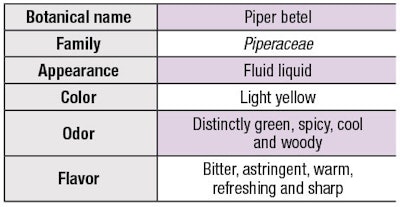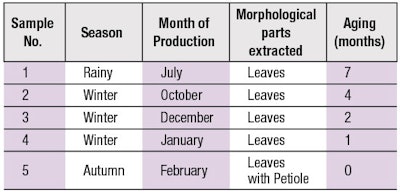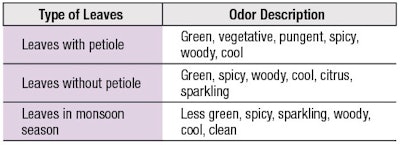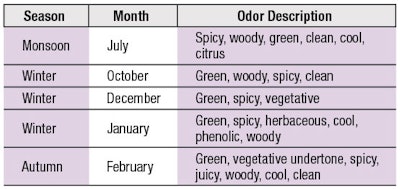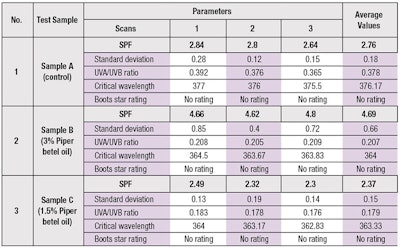
Editor’s note: The cosmetics industry has utilized natural extracts for decades, in some instances because they impart antimicrobial benefits—and are more appealing on product labels than traditional preservatives. There is also heightened interest in replacing both synthetic flavors and fragrances with natural essential oils and extracts. Add to these new concerns over COVID-19, which have multiplied the demand for natural oils and extracts having antibacterial properties, and the relevance of the present article to current product development becomes self-evident.
Piper betel is a climbing vine belonging to the family Piperaceae that is abundantly grown and distributed in many Asian countries. More popularly known as Paan leaves in India and Barui leaves in Bangladesh, Piper betel leaves are cultivated following traditional Indian methods on approximately 55,000 hectares of land with an annual production worth nearly Rs 9,000 million (approx. US $119 million).1
The leaves of this botanical contain high quantities of moisture, protein, fats, minerals, vitamins, phytochemicals and antioxidants.2-4, 13 Piper betel leaves have been used in traditional medicine as carminative, stimulant, antiseptic, antifungal and antibacterial agents. They also have been utilized to treat diseases caused by bacteria and fungi; for example, halitosis, boils, abscesses, conjunctivitis, constipation, headaches and many other ailments.2-4
Considering the myriad of uses for Piper betel leaves, several leaf oil samples were derived and characterized as described herein for potential cosmetic applications. Following is a brief background of the plant and overview of its active constituents; taste and aroma characterizations of the sample oils; comparisons in the oils as a function of age, climate and leaf parts; as well as exploratory tests for antibacterial and UV filtering effects.
Plant Characteristics
There are 34 varieties of Piper betel leaves found in India and they are most commonly used for food. Betel leaves from different regions vary in smell and taste as well as essential oil content. In fact, the oil content of various Indian leaf types, such as Kalipatti, Ramtek, Bangla, etc., can range from 0.7% to 2.6%—and the most important factor determining the aromatic value of the leaf is the amount and nature of its essential oil.3, 10
Kalipatti is a variety grown in the Maharashtra region. It has thick and dark leaves, a pungent scent and is wilt-resistant. This aromatic creeper has heart-shaped, smooth, long-stalked leaves with a pointed apex. They grow from 5-20 cm in length and characteristically are broadly ovate, slightly cordate, shiny on both sides and often unequal at the base with a glabrous, yellowish or bright green appearance.3
A betel leaf plant has a life span of about five to six years.10 During its growth cycle, at approx. Day 15, the leaves at the 3rd or 4th node down from the plant’s apex are tender and considered ideal for plucking for oil extraction or edible uses. Once the plant reaches a length of 7 ft to 8 ft (approx. 2 m to 2.4 m), the lower portion of the creeper is coiled and tied at the bottom to a support stick, close to the soil, thus lowering the creeper to a height of 2 ft (approx. 0.6 m) from the soil. Adventitious roots also arise from the nodes, which provide the plant with a new rooting system.4, 11
The chemical constituents of Piper betel leaf have previously been described12 and include: piperol-A, piperol-B, methyl piper betlol and essential oil composed primarily of terpinen-4-ol, safrole, allyl pyrocatechol monoacetate, eugenol and other components. The leaf is also rich in antioxidants; polyphenols such as eugenol, chavicol, carvacrol, chavibetol, catechol, allylpyrocatechol; and vitamin C. Thanks to this variety of constituents, Piper betel leaf oil exhibits many potential cosmetic applications, hence its present evaluation for aromatic, antibacterial and UV-protective benefits.5, 13
Materials and Methods
Kalipatti variety Piper betel leaf oils were first obtained by hydro-distillation, then tested for organoleptic properties, physicochemical constituents, antibacterial potential and UV absorbance.
Leaf oil: Fresh leaves, having matured between 15 to 17 days, were used to extract essential oil samples. Leaves were first cleaned using water, then air-dried, followed by water distillation at 60°C.6, 10 Essential oil yields for 500 g of leaves with and without a petiole, i.e., the stalk joining the plant’s leaf to its stem, were compared. The average yield obtained from leaves with petioles (0.5 g) was higher than for those without petioles (0.3 g).
Test methods: Briefly, odor profiles were assessed by a panel of 10 trained experts who observed, by the magnitude estimation method, changes as a function of age, climate and leaf parts. Gas chromatographya was used to evaluate the chemical composition of the oils.7 Antimicrobial activity was assessed using the E test and agar diffusion platesb, and UV protection, by a spectrophotometerc.8, 9
Organoleptic Properties and Chemical Constituents
As outlined in Table 1, the leaf oils generally demonstrated a pungent and sharp taste, as observed by the 10 panelists, Table 2 additionally shows their physical properties, as determined by refractive index and other standard assessments; notably the oils are soluble in ethanol and organic solvents. The odor profiles of the extracted oils were further compared by the magnitude estimation method. The oils were segregated based on their month of production, the season of harvest and morphological part used for extraction (see Table 3). These samples were then compared by the 10 trained experts to observe the effects of the morphological parts extracted, climate and aging on the odor profiles of the oils.
Morphological parts: The oils obtained from only Piper betel leaves had green, spicy, sparkling, woody and cool notes. The oil obtained from leaves with their petioles exhibited the same notes but also a distinct vegetative note (see Table 4).
Climatic conditions: The odor profile of betel leaf oils obtained during monsoon season had a less prominent vegetative undertone and more “clean” and spicy notes than the other samples. Furthermore, vegetative and woody notes increased with decreasing moisture, which is observed with the progression of dry weather (see Table 5).
Odor change with age: The age of the oils also changed the odor profile. Oils aged eight months demonstrated prominent spicy notes, distinctly on the lines of citrus, and less herbaceous notes. Vegetative aspects were prominent in fresh, one-day aged oil, which decreased with age, as did the harshness of this characteristic. Also in one-day aged oil, the burnt note was prominent and this decreased with age (see Table 6).
Hence, the oils appeared to develop higher quality and clearer notes with age. The yield of the oils increased with the petiole parts, rather the leaves-only, and the oil obtained during the rainy season exhibited better notes, compared with other seasons.
Chemical constituents: Finally, gas chromatographya revealed the chemical constituents of the petiole-plus-leaf oil derived during monsoon season, which interestingly included 27.66% safrole. In general, results were in agreement with previous reports (see Table 7).
Antimicrobial Properties
As noted, Piper betel leaf oil from the Kalipatti variety also was evaluated for antimicrobial properties for the skin.
The same petiole-plus-leaf derived during monsoon (0.5%) oil itself was tested, as was its application in a test cream formula (see Formula 1). Antimicrobial activity was determined against Gram-positive (S. aureus) and Gram-negative (E. coli) bacteria using the E test with agar platesb and the pour plate method.
Oil efficacy: The bacterial culture was spread over two different media plates and paper strips containing betel leaf oil (or not) were placed over the culture and allowed to diffuse. All plates were kept under observation for 48 hr in an incubator at 37°C. Figures 1 and 2 show how betel leaf oil staved off E. coli and S. aureus growth, respectively.
Oil in test cream efficacy: The oil was next incorporated or not (control) at different levels into a simple o/w emulsion base (see Formula 1) and evaluated again for antimicrobial properties. The emulsions were evaluated by the pour plate method and again, the samples where tested against E. coli and S. aureus (see Figures 3 and 4). The Piper betel leaf oil test formulas acted effectively against both bacteria, although the 3% oil showed better results against Gram-positive bacteria than against Gram-negative bacteria.
UV Absorption
Finally, the same Piper betel petiole-and-leaf oil obtained during monsoon was examined for its potential to absorb UV. While no previous literature reported this benefit, the spectrophotometric test results were promising and prompted further SPF testing.
First, a 10-μL oil sample was mixed with 990 μL of chloroform as a diluent and analyzed by spectrophotometerc. The oil demonstrated high UV absorption in the complete UVB region (250-290 nm), although no activity was observed in UVA or UVC wavelengths (see Figure 5). The highest absorbance was noted at 4.2 nm, suggesting Piper betel leaf oil affords UV-B protection properties.
Next, the same test cream bases prepared earlier (see Formula 1) were evaluated for SPF using an ultraviolet transmittance analyzerd (see Figure 5). The values obtained were between SPF 4.62 and 4.8 at a 3% Piper betel leaf oil concentration, and between 2.3 and 2.49 for a 1.5% concentration. The control cream devoid of Piper betel leaf oil exhibited an SPF of 2.76; none of the test creams achieved any Boots star rating (see Table 8).
Discussion and Conclusions
Kalipatti variety Piper betel leaf oil was obtained by hydro-distillation. The oil yield maximum was 0.5 g with both the leaves and petioles. Gas chromatography revealed the chemical constituents of the oil, which interestingly included 27.66% safrole.
The general odor profile of the oil was distinctly green, spicy, cool and woody; although odor comparisons of oil derived from the leaves and petioles revealed green, vegetative, pungent, spicy, woody and cool notes; whereas oil from the leaves only demonstrated similar green, spicy, woody and cool notes, but also citrus and “sparkling” characteristics.
Evaluations based on climatic conditions during the plant’s growth showed that vegetative and woody notes increased with a decrease in moisture in the oil, which is seen with the progression of dry weather. Another evaluation explored the effects of aging and showed oil aged eight months had prominently spicy notes, distinctly on the lines of citrus and less herbaceous.
An antimicrobial test showed that 0.5% Piper betel leaf oil at ~1.5% and 3% concentrations had an inhibitory effect against E. coli and S. aureus strains of bacteria. When incorporated in a cream base, the oil also demonstrated antibacterial properties. Finally, the oil imparted an average SPF of 4.69 at a 3% concentration but had a moderate UVA/UVB ratio at a 1.5% concentration. Notably, the role of safrole, which is present at high levels in this extract, is under investigation. It affects the aroma of the oil and could, potentially, influence the SPF.
Taken together, it can be concluded that Piper betel leaf oil of the Kalipatti variety affords benefits with potential application in personal care products; e.g., as an antibacterial active. It is recommended for mixing with other essential oils to create a blend that works as a natural antimicrobial for hand rubs, body washes, shampoos and the like.
References
- Chauhan, E.S., Aishwarya, J., Singh, A. and Tiwari, A. A review: Nutraceuticals properties of Piper betel (Paan). Ameri J of Phytomed and Clin Thera. ISSN 2321-2748.
- Dwivedi, V. and Tripathi, S. (2014). Review study on potential activity of Piper betel. J of Pharma and Phyto. 3(4) 93-98.
- The Wealth of India–Raw Material Series (1969). Volume VII, CSIR/ NSCIR publication.
- Guha, P. (2006). Betel leaf: The neglected green gold of India. J Hum Ecol 19(2) 87-93.
- Kokate, C.K., Purohit, A.P. and Gokhale, S.B. (2008, Mar 10). Pharmacognosy.
- Durrans, T.H. (1922). The distillation of essential oils. Distillation Principles and Processes. Macmillan and Co.
- Datta, A., Ghoshdastidar, S. and Singh, M. (2011). Antimicrobial property of Piper betel leaf against clinical isolates of bacteria. Intl J Pharma Sci Res. 2(3) 104-109.
- Caburian, A.B. and Osi, M.O. (2011). Characterization and evaluation of antimicrobial activity of the essential oil from the leaves of Piper betel L. Intl J Current Pharma Res. ISSN- 0975-7066, vol 3(2).
- Caburian, A.B. and Osi, M.O. (2010). Characterization and evaluation of antimicrobial activity of the essential oil from the leaves of Piper betel L. Intern Sci Res J. ISSN: 2094-1749, vol 2(1).
- Handa, S.S. and Kaul, M.K. (1996). Supplement to cultivation and utilization of aromatic plants. Regional research laboratory, Council of Scientific & Industrial Research.
- Pin, K.Y., et al. (2006). Aqueous extraction of hydroxychavicol from Piper betel L. leaves. E-Intl Sci Res J. ISSN: 2094-1749, vol 2(1).
- Bajpai, V., Sharma, D., Kumar, B. and Madhusudanan, K.P. (2010, Dec). Profiling of Piper betel Linn. cultivars by direct analysis in real time mass spectrometric technique. Biomed Chromatogr. 24(12) 1283-1286.
- Majumdar, B., Chaudhuri, S.R. and Roy, A. (2003, Apr). Effect of ethanol extract of leaf of Piper betel Linn. leaf on healing of NSAID-induced experimental ulcer—A novel role of free radical scavenging action. Indian J Exp Biol. 41(4) 311-315.
Captions/Footnotes:
a Trace GC Ultra 2.0 Gas Chromatograph, ThermoFisher
b E test or Epsilometer test, bioMérieux
c Genesys 10S UV-VIS Spectrophotometer, Applied Biosystem
d UV-2000S Ultraviolet Transmittance Analyzer, Labsphere Inc.

